1988 PONTIAC FIERO engine oil
[x] Cancel search: engine oilPage 667 of 1825
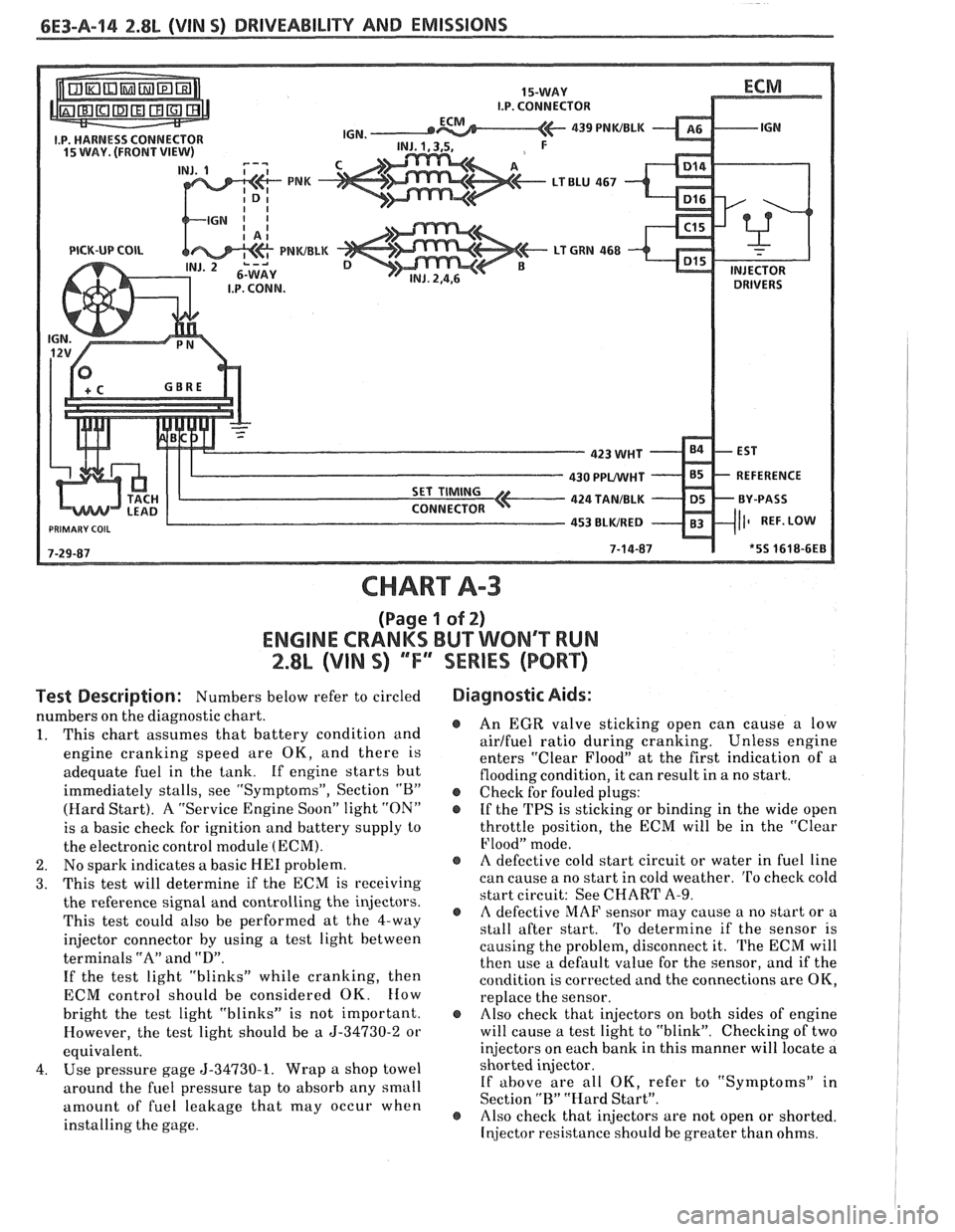
6E3-A-14 2.8L (VIN S) DRIVEABILITY AND EMISSIONS
PICK-UP COIL
CHART A-3
(Page 1 of 2)
ENGINE CRANKS BUT WON'T RUN
2.8L (VIN S) ""F'" SERIES (PORT)
Test Description: Numbers below refer to circled
numbers on the diagnostic chart.
1. This chart
assunles that battery condition and
engine cranking speed are OK, and there is
adequate fuel in the tank. If engine starts but
immediately stalls, see "Symptoms", Section
"B"
(Hard Start). A "Service Engine Soon" light "ON"
is a basic check for ignition and battery supply to
the electronic control module
(ECM).
2. No sparlc indicates a basic HE1 problem.
3. This test will determine if the ECM is receiving
the reference signal and controlling the injectors.
This test could also be performed at the 4-way
injector connector by using a test light between
terminals
"A" and "D".
If the test light "blinks" while cranking, then
ECM control should be considered OK.
How
bright the test light "blinks" is not important.
However, the test light should be a
5-34730-2 or
equivalent.
4. Use pressure gage 5-34730-1. Wrap a shop towel
around the fuel pressure tap to absorb any small
amount of fuel leakage that may occur when
installing the gage.
Diagnostic Aids:
@ An EGR valve sticking open can cause a low
airlfuel ratio during cranking. Unless engine
enters "Clear Flood" at the first indication of a
flooding condition, it can result in a no start.
@ Check for fouled plugs:
@ If the TPS is sticking or binding in the wide open
throttle position, the ECM will be in the "Clear
Flood" mode.
@ A defective cold start circuit or water in fuel line
can cause a no start in cold weather.
To check cold
start circuit: See CHART
A-9.
e A defective MAF sensor may cause a no start or a
stall after start. 'I'o determine if the sensor is
causing the problem, disconnect it. The ECM will
then use a default value for the sensor, and if the
condition is corrected and the connections are OK,
replace the sensor.
@ Also check that injectors on both sides of engine
will cause a test light to "blink". Checking of two
injectors on each bank in this manner will locate a
shorted injector.
If
above are all OK, refer to "Symptoms" in
Section
"R" "Hard Start".
@ Also checlc that injectors are not open or shorted.
Injector resistance should be greater than ohms.
Page 705 of 1825
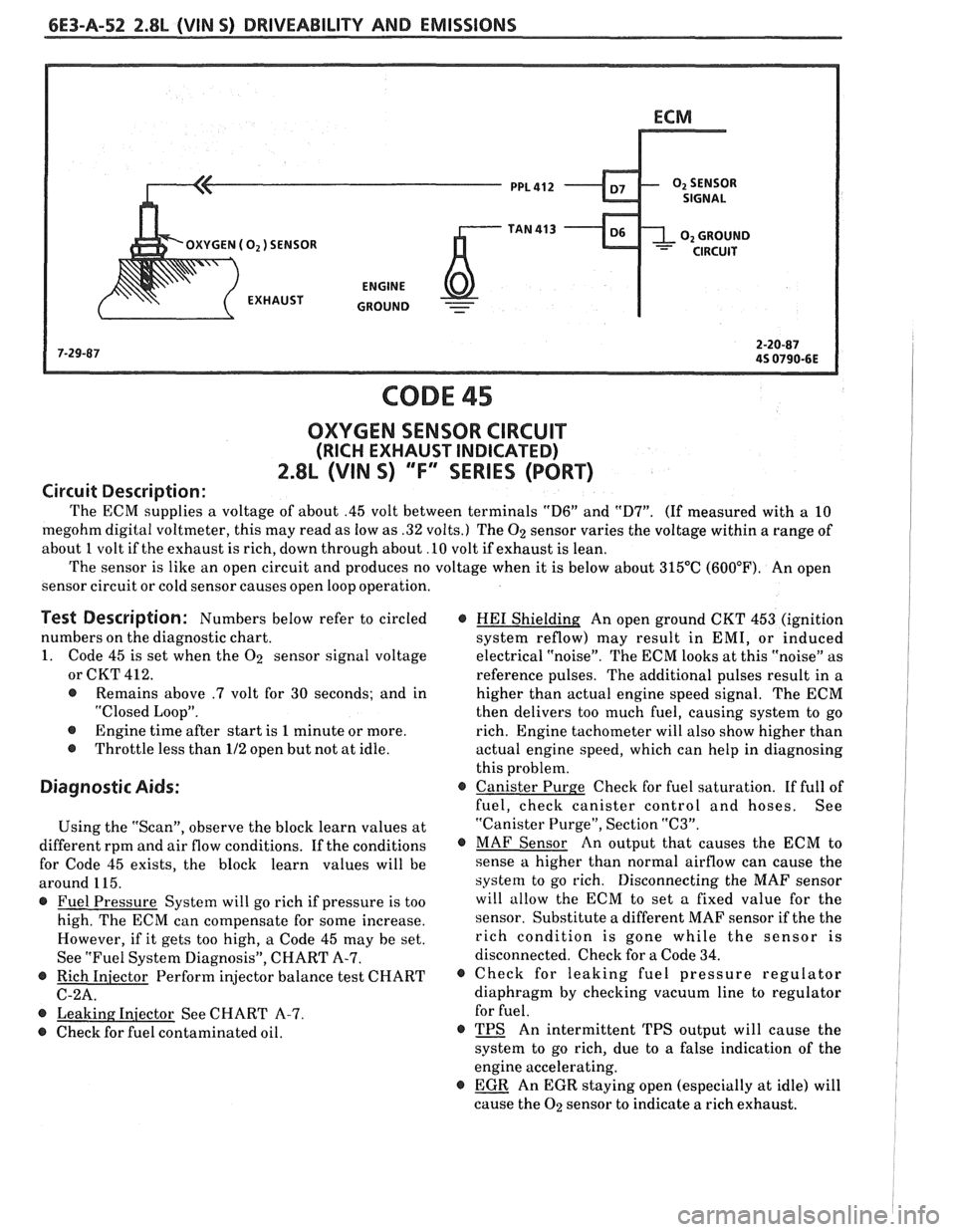
6E3-A-52 2.8L (VIN S) DRIVEABILITY AND EMISSIONS
- GROUND - -
CODE 45
OXYGEN SENSOR CIRCUIT
(RICH EXHAUST INDICATED)
2.8L (VIN S) "F" SERIES (PORT)
Circuit Description:
The ECM supplies a voltage of about .45 volt between terminals "D6" and "D7". (If measured with a 10
megohm digital voltmeter, this may read as low as .32 volts.) The
02 sensor varies the voltage within a range of
about
1 volt if the exhaust is rich, down through about .LO volt if exhaust is lean.
The sensor is like an open circuit and produces no voltage when it is below about 315°C (600°F). An open
sensor circuit or cold sensor causes open loop operation.
Test Description: Numbers below refer to circled
numbers on the diagnostic chart.
1. Code 45 is set when the
02 sensor signal voltage
or CKT 412.
@ Remains above .7 volt for 30 seconds; and in
"Closed LoopJ'.
@ Engine time after start is 1 minute or more.
@ Throttle less than 112 open but not at idle.
Diagnostic Aids:
Using the "Scan", observe the block learn values at
different rpm and air flow conditions. If the conditions
for Code 45 exists, the block learn values will be
around 1 15.
@ Fuel Pressure System will go rich if pressure is too
high. The ECM can compensate for some increase.
However, if it gets too high, a Code 45 may be set.
See "Fuel System Diagnosis", CHART A-7.
@ Rich Iniector Perform injector balance test CHART
C-2A.
@ Leaking Iniector See CHART A-7.
@ Check for fuel contaminated oil.
@ An open ground CKT 453 (ignition
system
reflow) may result in EMI, or induced
electrical "noise". The ECM looks at this "noise" as
reference pulses. The additional pulses result in a
higher than actual engine speed signal. The ECM
then delivers too much fuel, causing system to go
rich. Engine tachometer will also show higher than
actual engine speed, which can help in diagnosing
this problem.
@ Canister Purge Check for fuel saturation. If full of
fuel, check canister control and hoses. See
"Canister Purge", Section
"C3".
@ MAF Sensor An output that causes the ECM to
sense a higher than normal airflow can cause the
system to go rich. Disconnecting the MAF sensor
will allow the ECM to set
a fixed value for the
sensor. Substitute a different MAF sensor if the the
rich condition is gone while the sensor is
disconnected. Check for a Code 34.
@ Check for leaking fuel pressure regulator
diaphragm by checking vacuum line to regulator
for fuel.
@ TB An intermittent TPS output will cause the
system to go rich, due to a false indication of the
engine accelerating.
@ E]CR An EGR staying open (especially at idle) will
cause the
02 sensor to indicate a rich exhaust.
Page 711 of 1825
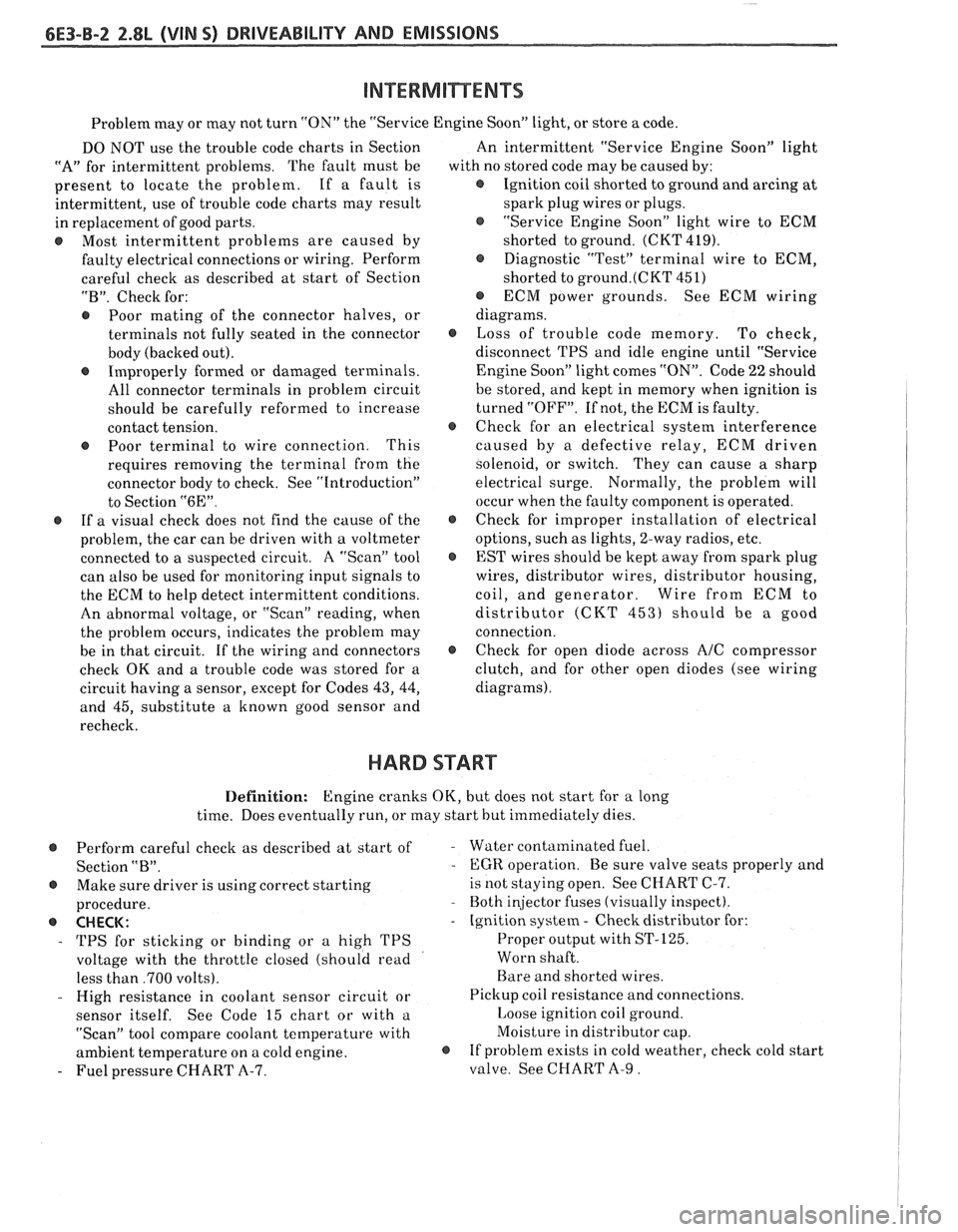
6E3-B-2 2.8L (VIN 5) DRIVEABILITY AND EMISSIONS
Problem may or may not turn "ON" the "Service Engine SoonJ' light, or store a code.
DO NOT use the trouble code charts in Section
"A" for intermittent problems. The fault must be
present to locate the problem. If a fault is
intermittent, use of trouble code charts may result
in replacement of good parts.
@ Most intermittent problems are caused by
faulty electrical connections or wiring. Perform
careful check as described at start of Section
"B". Check for:
@ Poor mating of the connector halves, or
terminals not fully seated in the connector
body (backed out).
@ Improperly formed or damaged terminals.
All connector terminals in problem circuit
should be carefully reformed to increase
contact tension.
@ Poor terminal to wire connection. This
requires removing the terminal from the
connector body to check. See "Introduction"
to Section
"6E".
@ If a visual check does not find the cause of the
problem, the car can be driven with a voltmeter
connected to a suspected circuit. A "Scan" tool
can also be used for monitoring input signals to
the ECM to help detect intermittent conditions.
An abnormal voltage, or "Scan" reading, when
the problem occurs, indicates the problem may
be in that circuit. If the wiring and connectors
check OK and a trouble code was stored for a
circuit having a sensor, except for Codes
43, 44,
and 45, substitute a known good sensor and
recheck. An
intermittent "Service Engine Soon" light
with no stored code may be caused by:
@ Ignition coil shorted to ground and arcing at
spark plug wires or plugs.
@ "Service Engine Soon" light wire to ECM
shorted to ground. (CKT 419).
@ Diagnostic "Test" terminal wire to ECM,
shorted to
ground.(CKT 451)
@ ECM power grounds. See ECM wiring
diagrams.
@ Loss of trouble code memory. To check,
disconnect TPS and idle engine until "Service
Engine Soon" light comes "ON". Code
22 should
be stored, and kept in memory when ignition is
turned "OFF". If not, the ECM is faulty.
@ Check for an electrical system interference
caused by a defective relay, ECM driven
solenoid, or switch. They can cause
a sharp
electrical surge. Normally, the problem will
occur when the faulty component is operated.
@ Check for improper installation of electrical
options, such as lights, 2-way radios, etc.
@ EST wires should be kept away from spark plug
wires, distributor wires, distributor housing,
coil, and generator. Wire from ECM to
distributor (CKT
453) should be a good
connection.
@ Check for open diode across A/C compressor
clutch, and for other open diodes (see wiring
diagrams).
HARD START
Definition: Engine cranks OK, but does not start for a long
time. Does eventually run, or may start hut immediately dies.
@ Perform careful check as described at start of -
Section "B".
@ Make sure driver is using correct starting
procedure.
@ CHECK:
- TPS for sticking or binding or a high TPS
voltage with the throttle closed (should read
less than
,700 volts).
- High resistance in coolant sensor circuit or
sensor itself. See Code 15 chart or with
a.
"Scan" tool compare coolant temperature with
ambient temperature on
a cold engine. 8
- Fuel pressure CHART A-7. Water contaminated
fuel.
EGR operation. Be sure valve seats properly and
is not staying open. See CHART C-7.
Both injector fuses (visually inspect).
Ignition system
- Check distributor for:
Proper output with ST-125.
Worn shaft.
Bare and shorted wires.
Pickup coil resistance and connections.
Loose ignition coil ground.
Moisture in distributor cap.
If problem exists in cold weather, check cold start
valve. See CHART A-9.
Page 712 of 1825
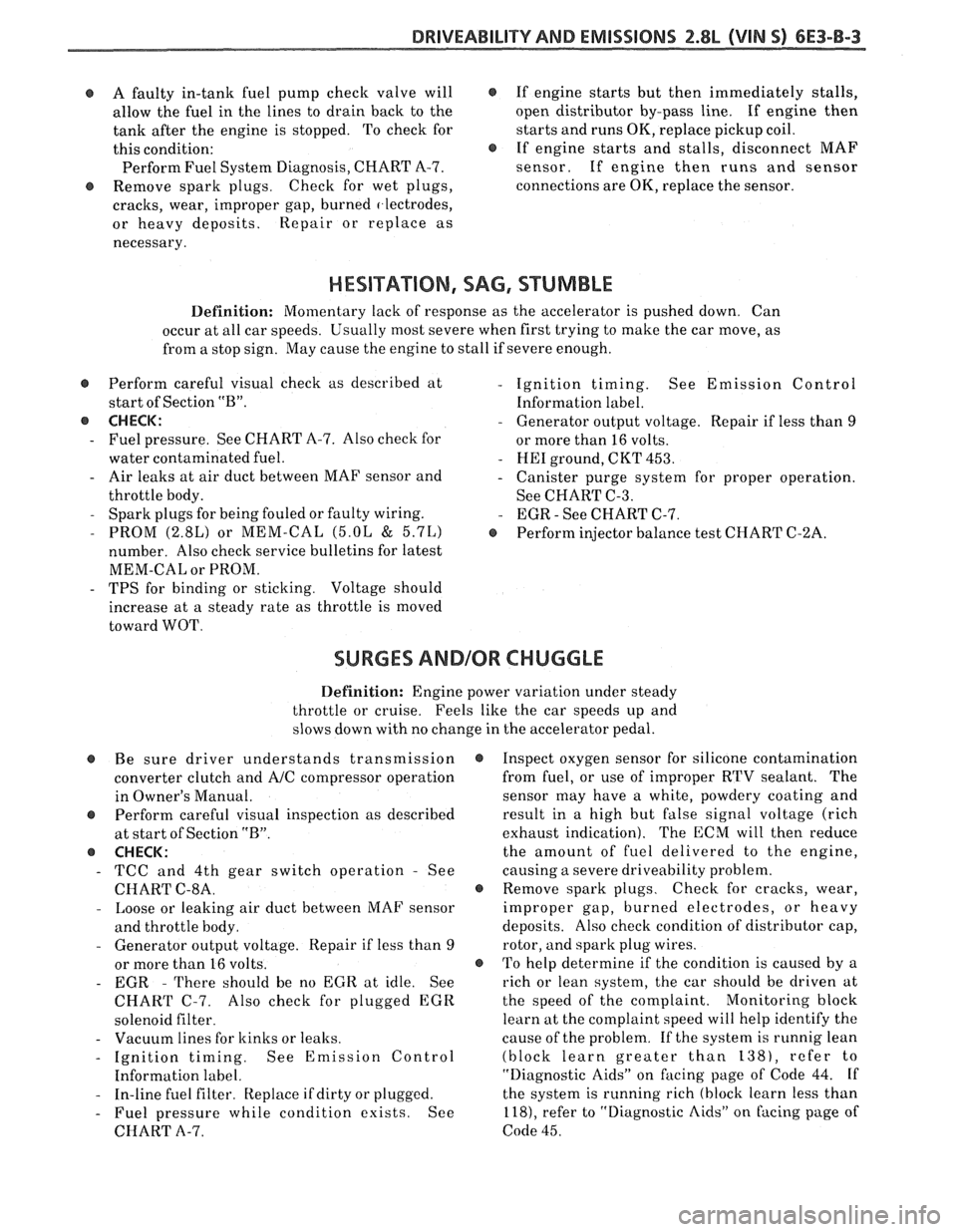
DRIVEABILITY AND EMISSIONS 2.8L (VIN S) 6E3-B-3
e A faulty in-tank fuel pump check valve will @ If engine starts but then immediately stalls,
allow the fuel in the lines to drain back to the open
distributor by-pass line. If engine then
tank after the engine is stopped. To check for starts
and runs OK, replace pickup coil.
this condition:
@ If engine starts and stalls, disconnect MAF
Perform Fuel System Diagnosis, CHART A-7. sensor. If engine then runs and sensor
@ Remove spark plugs. Check for wet plugs, connections are OK, replace the sensor.
cracks, wear, improper gap, burned
f lectrodes,
or heavy deposits. Repair or replace as
necessary.
HESITATION, SAG, STUMBLE
Definition: Momentary lack of response as the accelerator is pushed down. Can
occur at all car speeds.
Usually most severe when first trying to make the car move, as
from a stop sign. May cause the engine to stall if severe enough.
Perform careful visual check as described at
start of Section
"B".
a CHECK:
- Fuel pressure. See CHART A-7. Also check for
water contaminated fuel.
- Air leaks at air duct between MAF sensor and
throttle body.
- Spark plugs for being fouled or faulty wiring.
- PROM (2.8L) or MEM-CAL (5.OL & 5.7L)
number. Also check service bulletins for latest
MEM-CAL or PROM.
- TPS for binding or sticking. Voltage should
increase at a steady rate as throttle is moved
toward WOT.
- Ignition timing. See Emission Control
Information label.
- Generator output voltage. Repair if less than 9
or more than 16 volts.
- HE1 ground, CKT 453.
- Canister purge system for proper operation.
See CHART C-3.
- EGR - See CHART C-7.
@ Perform injector balance test CHART C-2A.
SURGES AND/OR CHUGGLE
Definition: Engine power variation under steady
throttle or cruise. Feels like the car speeds up and
slows down with no change in the accelerator pedal.
Be sure driver understands transmission
converter clutch and
A/C compressor operation
in Owner's Manual.
e Perform careful visual inspection as described
at start of Section
"B".
CHECK:
- TCC and 4th gear switch operation - See
CHART C-8A.
- Loose or leaking air duct between MAF sensor
and throttle body.
- Generator output voltage. Repair if less than 9
or more than 16 volts.
- EGR - There should be no EGR at idle. See
CHART C-7. Also check for plugged EGR
solenoid filter.
- Vacuum lines for kinks or leaks.
- Ignition timing. See Emission Control
Information label.
- In-line fuel filter. Replace ifdirty or plugged.
- Fuel pressure while condition exists. See
CHART A-7.
@ Inspect oxygen sensor for silicone contamination
from fuel, or use of improper RTV sealant. The
sensor may have a white, powdery coating and
result in a high but false signal voltage (rich
exhaust indication). The ECM will then reduce
the amount of fuel delivered to the engine,
causing a severe driveability problem.
@ Remove spark plugs. Check for cracks, wear,
improper gap, burned electrodes, or heavy
deposits. Also check condition of distributor cap,
rotor, and spark plug wires.
@ To help determine if the condition is caused by a
rich or lean system, the car should be driven at
the speed of the complaint. Monitoring block
learn at the complaint speed will help identify the
cause of the problem. If the system is runnig lean
(block learn greater than
138), refer to
"Diagnostic Aids" on
facing page of Code 44. If
the system is running rich (block learn less than
118), refer to "Diagnostic Aids" on facing page of
Code 45.
Page 713 of 1825

&E3-B-4 %.8L (VIN S) DRIVEABILITY AND EMISSIONS
LACK OF POWER, SLUGGISH, OR SPONGY
Definition: Engine delivers less than expected power. Little or
no increase in speed when accelerator pedal is pushed down part way.
Perform careful visual check as described at
- EGR operation for being open or partly open all
start of Section
"B". the time - CHART C-7.
e Compare customer's car to similar unit. - Exhaust system for possible restriction: See
Make sure the customer's car has an actual CHART
B-1,
problem.
@ Remove air cleaner and check air filter for
dirt, or for being plugged. Replace as
necessary.
@ CHECK:
- For loose or leaking air duct between MAF
Sensor and throttle body.
- Ignition timing. See Emission Control
Information label.
- Restricted fuel filter, contaminated fuel or
improper fuel pressure. See CHART A-7.
- ECM ground circuits - See ECM wiring
diagrams.
- Inspect exhaust system for damaged or
collapsed pipes.
- Inspect muffler for heat distress or possible
internal failure.
- Generator output voltage. Repair if less than 9
or more than 16 volts.
- Engine valve timing and compression.
- Engine for proper or worn camshaft. See
Section
"6A".
- Secondary voltage using a shop ocilliscope or a
spark tester
5-26792 (ST-125) or equivalent.
DETONATION ISPARK KNOCK
Definition: A mild to severe ping, usually worse under
acceleration. The engine makes sharp metallic knocks that
change with throttle opening. Sounds like popcorn popping.
@ Check for obvious overheating problems:
- Low coolant.
- Loose water pump belt.
- Restricted air flow to radiator, or restricted
water flow thru radiator.
- Inoperative electric cooling fan circuit. See
CHART C-12.
@ CHECK:
- Ignition timing. See Vehicle Emission
Control Information label.
- EGR system for not opening - CHART C-7.
- TCC operation - CHART C-8.
- Fuel system pressure. See CHART A-7.
- PROM or MEM-CAL - Be sure it's the correct
one. (See Service Bulletins)
- Valve oil seals for leaking.
@ Check for incorrect basic engine parts such as
cam, heads, pistons, etc.
@ Check for poor fuel quality.
@ Remove carbon with top engine cleaner. Follow
instructions on can.
@ Check ESC system (5.OL & 5.7L)
See CHART C-5
o To help determine if the condition is caused by a
rich or lean system, the car should be driven at
the speed of the complaint.
Monitoring block
learn at the complaint speed will help identify the
cause of the problem.
If the system is runnig lean
(block learn greater than
1381, refer to
"Diagnostic Aids" on facing page of Code 44.
If
the system is running rich (block learn less than
l18), refer to "Diagnostic Aids" on facing page of
Code 45.
Page 714 of 1825
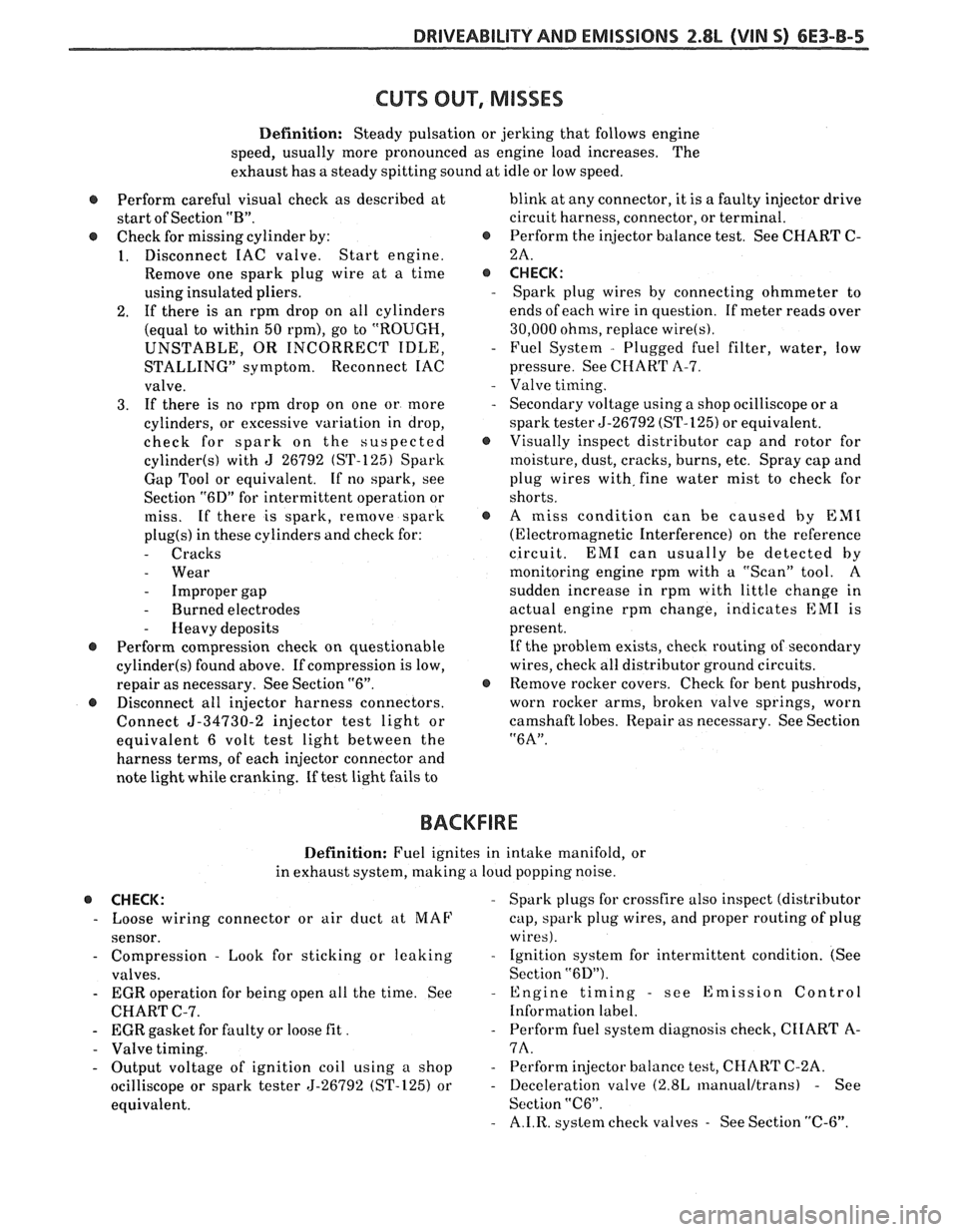
DWI\/EABILITV AND EMISSIONS 2.8L (VIN 5) 6E3-B-5
CU"T SUP, MISSES
Definition: Steady pulsation or jerking that follows engine
speed, usually more pronounced as engine load increases. The
exhaust has a steady spitting sound at idle or low speed.
@ Perform careful visual check as described at
start of Section
"B".
@ Check for missing cylinder by:
1. Disconnect IAC valve. Start engine.
Remove one spark plug wire at a time
using insulated pliers.
2. If there is an rpm drop on all cylinders
(equal to within
50 rpm), go to "ROUGH,
UNSTABLE, OR INCORRECT IDLE,
STALLING" symptom. Reconnect IAC
valve.
3. If
there is no rprn drop on one or more
cylinders, or excessive variation in drop,
check for spark on the suspected
cylinder(s) with J 26792 (ST-125) Spark
Gap Tool or equivalent.
If no spark, see
Section
"6D" for intermittent operation or
miss. If there is spark, remove spark
plug(s) in these cylinders and check for:
- Cracks
- Wear
- Improper gap
- Burned electrodes
- Iieavy deposits
@ Perform compression check on questionable
cylinder(s) found above. If compression is low,
repair as necessary. See Section
"6".
@ Disconnect all injector harness connectors.
Connect
5-34730-2 injector test light or
equivalent 6 volt test light between the
harness terms, of each injector connector and
note light while cranking. If test light fails to blink
at any connector, it is a faulty injector drive
circuit harness, connector, or terminal.
@ Perform the injector balance test. See CHART C-
2A.
s CHECK:
- Spark plug wires by connecting ohmmeter to
ends of each wire in question. If meter reads over
30,000 ohms, replace wire(s1.
- Fuel System - Plugged fuel filter, water, low
pressure. See
CHART A-7.
- Valve timing.
- Secondary voltage using a shop ocilliscope or a
spark tester 5-26792 (ST-125) or equivalent.
@ Visually inspect distributor cap and rotor for
moisture, dust, cracks, burns, etc. Spray cap and
plug wires with, fine water mist to check for
shorts.
@ A miss condition can be caused by EM1
(Electromagnetic Interference) on the reference
circuit.
EM1 can usually be detected by
monitoring engine rpm with a "Scan" tool. A
sudden increase in rpm with little change in
actual engine rpm change, indicates
EM1 is
present. If the problem exists, check routing of secondary
wires, check all distributor ground circuits.
@ Remove rocker covers. Check for bent pushrods,
worn rocker arms, broken valve springs, worn
camshaft lobes. Repair as necessary. See Section
"6A".
BACKFIRE
Definition: Fuel ignites in intake manifold, or
in exhaust system, making a loud popping noise.
CHECK:
- Loose wiring connector or air duct at MAF
sensor.
- Compression - Look for sticking or leaking
valves.
- EGR operation for being open all the time. See
CHART C-7.
- EGR gasket for faulty or loose fit .
- Valve timing.
- Output voltage of ignition coil using a shop
ocilliscope or spark tester 5-26792 (ST-125) or
equivalent.
- Spark plugs for crossfire also inspect (distributor
cap, spark plug wires, and proper routing of plug
wires).
- Ignition system for intermittent condition. (See
Section
"6D").
- Engine timing - see Emission Control
Information label.
- Perform fuel system diagnosis check, CIIART A-
7A.
- Perform injector balance test, CHART C-2A.
- Deceleration valve (2.8L ~nanualltrans) - See
Section
"C6".
- A.I.R. system check valves - See Section "C-6".
Page 723 of 1825
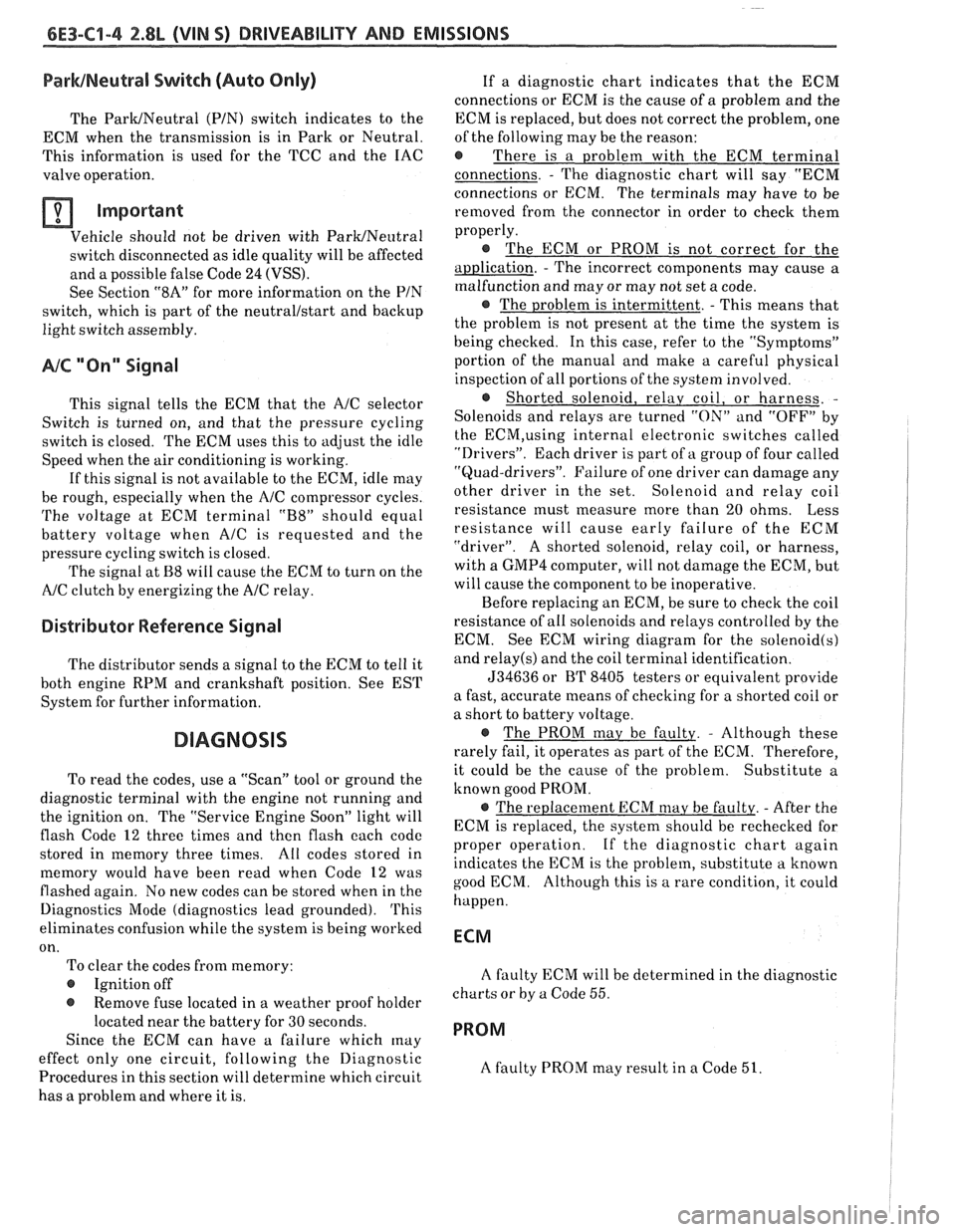
6E3-Cl-4 2.8L (VIN S) DRIVEABILITY AND EMISSIONS
BarWNeutral Switch (Auto Only)
The ParWNeutral (PIN) switch indicates to the
ECM when the transmission is in Park or Neutral.
This information is used for the TCC and the IAC
valve operation.
Important
Vehicle should not be driven with ParWNeutral
switch disconnected as idle quality will be affected
and a possible false Code
24 (VSS).
See Section "$A" for more information on the PIN
switch, which is part of the neutrallstart and backup
light switch assembly.
NC '"n" Signal
This signal tells the ECM that the A/C selector
Switch is turned on, and that the pressure cycling
switch is closed. The ECM uses this to adjust the idle
Speed when the air conditioning is working.
If this signal is not available to the ECM, idle may
be rough, especially when the
A/C compressor cycles.
The voltage at ECM terminal "B8" should equal
battery voltage when
AIC is requested and the
pressure cycling switch is closed.
The signal at
B8 will cause the ECM to turn on the
A/C clutch by energizing the A/C relay.
Distributor Reference Signal
The distributor sends a signal to the ECM to tell it
both engine RPM and crankshaft position. See EST
System for further information.
To read the codes, use a "Scan" tool or ground the
diagnostic terminal with the engine not running and
the ignition on. The "Service Engine Soon" light will
flash Code 12 three times and
then flash each code
stored in memory three times. All codes stored in
memory would have been read when Code 12 was
flashed again. No new codes can be stored when in the
Diagnostics Mode (diagnostics lead grounded).
This
eliminates confusion while the system is being worked
on. To clear the codes from memory:
@ Ignition off
@ Remove fuse located in a weather proof holder
located near the battery for 30 seconds.
Since the ECM can have
a failure which may
effect only one circuit, following the Diagnostic
Procedures in this section will determine which circuit
has a problem and where it is. If
a diagnostic chart indicates that the ECM
connections or ECM is the cause of
a problem and the
ECM is replaced, but does not correct the problem, one
of the following may be the reason:
€9
connections. - The diagnostic chart will say "ECM
connections or ECM. The terminals may have to be
removed from the connector in order to check them
properly.
@ The ECM or PROM is not correct for the
application.
- The incorrect components may cause a
malfunction and may or may not set a code.
@ The problem is intermittent. - This means that
the problem is not present at the time the system is
being checked. In this case, refer to the "Symptoms"
portion of the manual and make a careful physical
inspection of all portions of the system involved.
@ Shorted solenoid, relay coil, or harness. -
Solenoids and relays are turned "ON" and "OFF" by
the
ECM,using internal electronic switches called
"Drivers". Each driver is part of
a group of four called
"Quad-drivers". Failure of one driver can damage any
other driver in the set.
Solelloid and relay coil
resistance must measure more than 20 ohms. Less
resistance will cause early failure of the ECM
"driver". A shorted solenoid, relay coil, or harness,
with a GMP4 computer, will not damage the ECM, but
will cause the component to be inoperative.
Before replacing an ECM, be sure to check the coil
resistance of all solenoids and relays controlled by the
ECM. See ECM wiring diagram for the
solenoid(s)
and relay(s) and the coil terminal identification.
534636 or BT 8405 testers or equivalent provide
a fast, accurate means of checking for a shorted coil or
a short to battery voltage.
@ The PROM may be faulty. - Although these
rarely fail, it operates as part of the ECM. Therefore,
it could be the cause of the problem. Substitute a
known good PROM.
@ The replacement ECM may be faulty. - After the
ECM is replaced, the system should be rechecked for
proper operation. If the diagnostic chart again
indicates the ECM is the problem, substitute
a known
good ECM. Although this is a rare condition, it could
happen.
ECM
A faulty ECM will be determined in the diagnostic
charts or
by a Code 55.
PROM
A faulty PROM may result in a Code 51.
Page 733 of 1825
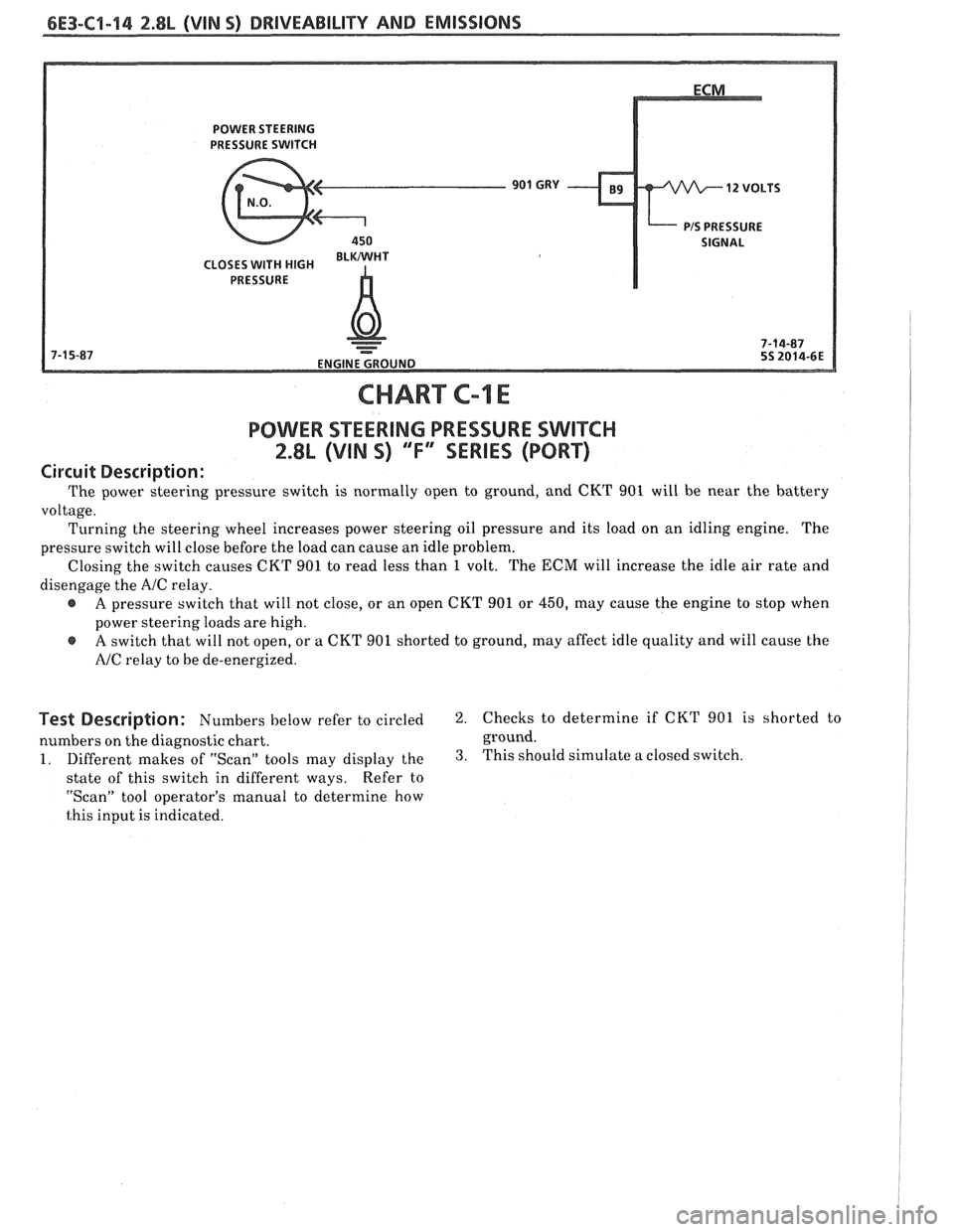
6E3-C4-14 2.8L (VIN S) BWiVEABlLlPV AND EMISSIONS
POWER STEERING
PRESSURE SWITCH
PIS PRESSURE
CLOSES
WITH HIGH BLWHT
PRESSURE
-
CHART C-1 E
POWER STEERING PRESSURE SWITCH
2.8L (VIN S) "F"" SERIES (PORT)
Circuit Description:
The power steering pressure switch is normally open to ground, and CKT 901 will be near the battery
voltage. Turning the steering wheel increases power steering oil pressure and its load on an idling engine. The
pressure switch will close before the load can cause an idle problem.
Closing the switch causes CKT 901 to read less than
1 volt. The ECM will increase the idle air rate and
disengage the
A/C relay.
e A pressure switch that will not close, or an open CKT 901 or 450, may cause the engine to stop when
power steering loads are high.
@ A switch that will not open, or a CKT 901 shorted to ground, may affect idle quality and will cause the
NC relay to be de-energized.
Bescription: Numbers below refer to circled 2. Checks to determine if CKT 901 is shorted to
numbers on the diagnostic chart. ground.
1. Different makes of "Scan" tools may display the 3. This should simulate
a closed switch.
state of this switch in different ways. Refer
to
"Scan" tool operator's manual to determine how
this input is indicated.